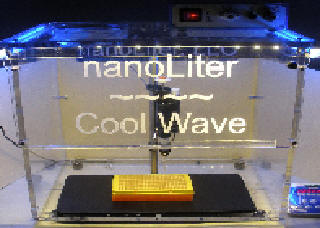

The Nanoliter Pipette.
Andrew D. Sauter III and Andrew D. Sauter, Jr., Nanoliter, LLC, 217 Garfield Drive, Henderson, NV 89074, USA 702-896-5413,adsauterjr@gmail.com
In three recent publications on nanoliter dispensing by induction based fluidics (IBF) (1,2,3) it has been shown counter intuitively that using the IBF nanoliter deposition technique can increase the sensitivity (2, 10 to 100 x, literally) and the reproducibility (3 to 20 X) of MALDI TOF MS analysis for proteins, peptides and synthetic polymers, as compared to using manual uL depositions. Devices used to realize these results were IBF modified syringes or pumps, but pipettes are also ubiquitous lab tools, as well. Here, we show that pipettes can be modified to realize the electric field enhanced (EFE) MALDI, and other nanoliter deposition tasks.
First, in this presentation, we review the definitions of qualitative and quantitative in mass spectrometry remembering the “Beer’s Law” for mass spectroscopy alluded to by Kiser (4). We then specifically show that quantitative and qualitative analysis by mass spectroscopy are simply different parts of the same equation (5, 6). Then we address the liquid handling aspects of the molar term of that approach, in an attempt to clarify why sample preparation difficulties have hindered quantitative and qualitative analysis in MS research, including the identification of disease and other biomarkers in proteomics and elsewhere.
Then, we present the physics of IBF, showing video of both hand held and robotic IBF dispensers used in MALDI and other MS sample preparation (e.g., LC/MALDI) to contrast it with current “practices” of infamy like the dried droplet “method.” We then discuss the analytical figures of merit of the nanoliter pipette and syringe morphs, showing that such simple devices can be used in both the non touch uL and nL regime for MALDI (and other) spotting applications. We show that the increased sensitivity and reproducibility inherent in EFE MALDI MS sample preparation of syringes and pumps translates into a pipette morph, and that it can significantly improve qualitative and quantitative mass spectrometry results.
1. T. Tu, A. D. Sauter III, A. D. Sauter Jr. and M.L. Gross, Improving the Signal Intensity and Sensitivity of MALDI Mass Spectroscopy by Using Nanoliter Spots Deposited By Induction Based Fluidics, poster session presented at ASMS 2007, Indianapolis, IN, June 2007. Also, Journal of the American Society of Mass Spectroscopy 2008, 19, 1086-1090
2. Brent Hilker, Kevin J. Clifford, Andrew D. Sauter Jr, Andrew D. Sauter III, and Julie P. Harmon, The Measurement of Charge for Induction Based Fluidic MALDI Dispense Event and Nanoliter Volume Verfication in Real Time, Journal of the American Society of Mass Spectroscopy, 2009, 20, 1064-1067.
3. Hilker, B.; Clifford, K. J.; Sauter Jr., A.D.; Sauter III, A.D.; Gauthier, T.; Harmon, J.P. Electric Field Enhanced Sample Preparation for Synthetic Polymer MALDI-TOF Mass Spectrometry via Induction Based Fluidics (IBF). ). Polymer, 50, 2009, 50 ,1015-1024.
4. R.W. Kiser, Introduction to Mass Spectrometry and Its Applications. Prentice-Hall Inc., 1965.
5. W.L. Fitch and A.D. Sauter, “Calculation of Relative Electron Impact Total Ionization Cross Sections for Organic Molecules,” Analytical Chemistry, 1983, 55, 832.
6. A.D. Sauter , et al, “Model for the Estimation of Electron Impact GC/MS Response Factors for Quadrupole Mass Spectrometers,” presented at the 1985 Pittsburgh Conference and Analytical Chemistry,1986, 58, 1665.